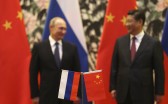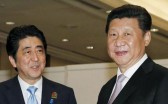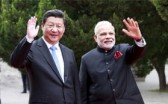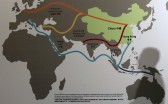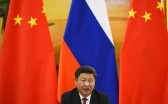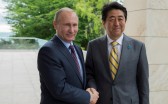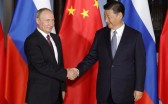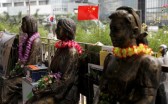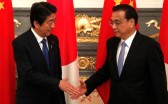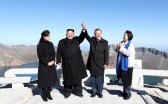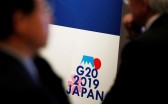One Belt and One Road, hereafter the new Silk Roads, is a Chinese initiative to connect different parts of regions in Asia. As a newly launched ambitious program from a rising power, it has incurred concerns, skepticism, and resistance from other players in the region. Indeed, in the positive scenario, skepticism and self-doubts are reported in China after the inauguration of the new Silk Roads. Skepticism and concerns are pervasive in the critical scenario drawing on the Japanese media. This policy brief strives to reconcile these competing scenarios in two parts. First, I position the new Silk Roads in the recent history of competitive regionalism in Asia. Second, I evaluate the three key skepticisms and propose counter thinking.
Competitive Cooperation in Asia:
Asia’s regionalism has a peculiar manner of progression. After WWII, Japan established a firm position as Asia’s top economy and trading nation. Economic elites in Japan proposed various visions of “re-Asianization,” which resulted in Japan’s close cooperation with Southeast Asian economies and deepening ties with China.1 Complicated intra-Asia politics, ambivalence in China, and resistance from the United States ultimately prevented Japan from assuming the leadership roles in newly founded regional organizations. Indeed, the Japan-funded Asian Development Bank (ADB) had to be headquartered in Manila, an East Asia-exclusive grouping (EAEC) had to be proposed by Malaysian leader Mahathir, and the strongest trade regime, Asia-Pacific Economic Cooperation (APEC), had to be led by the United States. In the 1990s, when the Japanese Ministry of Finance proposed the Asian Monetary Fund (AMF), the United States and the US-led International Monetary Fund (IMF) summarily vetoed it, despite the echoes from Taiwan and South Korea. The US opposition had strong help from resistant China. Japan’s failure to launch AMF deprived the region of a strong mechanism to counter the 1997-1998 Asian financial crisis (AFC).2
Thanks to the AFC and subsequent cooperation among Japan, China, and South Korea, Asian regionalism entered a new era of rapid growth: from the “organization gap” to a network of Track I, Track II, and Track III dialogues and frameworks, including ASEAN plus Three (APT), the Chiang Mai Initiative (CMI), East Asian Bond Market, East Asian Summit (EAS), Shanghai Cooperation Organization (SCO), Six-Party Talks (SPT), Boao Forum for Asia, Jeju Forum, and Network of East Asian Think Tanks (NEAT). The AFC’s effect was gone by 2005, and conventional barriers to Asian regionalism were resurgent: intra-regional mistrust, China-Japan rivalry, the US ambivalence, and other geopolitical and geo-economic factors.
China’s new Silk Road initiative grew out of the post-AFC achievements and recent impasse in Asian regionalism. Before the AFC, China had deep-rooted skepticism toward multilateralism and was concerned about any proposal that might constrain its regional policy. In 1994, it was critical of the ASEAN Regional Forum (ARF), and only after participation did it reluctantly join ARF. In 1996, it opposed Japan’s AMF proposal and, working parallel to the United States, effectively killed the proposal. After the AFC, however, China for the first time supported, initiated, and even led multilateral frameworks in the region, adopting what Michael Glosny calls a “charm offensive” by China.3
The Asian Infrastructure Investment Bank (AIIB) and Mutual Connectivity, two key components of the new Silk Roads initiative, were born out of China’s frustration with the recent impasse in regionalism. AIIB, for example, originated from China’s proposal for an East Asian infrastructure bank, which was vetoed by Japan. The Mutual Connectivity project originated from China’s previous proposal in SCO, which was going nowhere. Two additional disappointments also drove the new Silk Roads: China failed to increase its voting shares in the IMF, and it was being excluded from the US led Tran-Pacific Partnership (TPP).4 In short, China’s new regional initiative is long in making. It demonstrates China’s desire to lead regionalism; and yet, existing regional structures have not accommodated its new power and aspiration.
Evaluating the Skepticism
The above recap of Asian regionalism provides the background of China’s new Silk Roads initiative and puts the Japanese (and US) skepticism in perspective. Indeed, their skepticism is not surprising, given the complicated geopolitics and long tradition of intra-Asia mistrust and rivalry. The skepticism, as demonstrated in the negative scenario, consists of three arguments. First, it casts doubt on the utility of the Chinese initiative. Second, it questions China’s objectives in leading AIIB and the new Silk Roads. Third, it raises concerns about implementation of the new initiative.
On the first, it is easy to establish the instrumental values of China’s new Silk Road initiative. Asia has a huge demand for infrastructure investment, and millions of people are still hungry for economic opportunities. The Chinese initiative offered a Silk Road Fund of USD 40 billion, a Maritime Silk Road Fund of USD 20 billion, and the AIIB of USD 100 billion, in addition to bilateral commitments. These funds are bound to “scale up financing for sustainable development in Asia,” observes the United Nations.5 At the same time, China’s initiative has pressured Japan and other players to step up their investment and aid to Central and Southeast Asia. Prime Minister Abe, for example, made “unprecedented” visits to Central Asia and pledged USD 110 billion in infrastructure aid to the region. The ADB, pressured by the AIIB, has streamlined its approval procedures and cut the costs of its loans. Recently, Pakistan’s minister of development observed: “Thanks to China’s commitment to the China-Pakistan Economic Corridor, the world has seen Pakistan in a new light.”6
Second, the question of China’s intentions in the new Silk Roads is certainly valid; yet not very relevant to assess its implications for world development. I have outlined three drivers in China’s launching of One Belt One Road: 1) the economic rationale to diversity its investment and expand abroad; 2) the diplomatic rationale to build good neighborly relations; and 3) the strategic rationale to deal with backlashes against the rise of China.7 The three rationales have had varied importance at different points of time, and they may be all present in the Silk Roads initiative. However, if the Chinese initiatives promise to “scale up financing for sustainable development” and help develop the backward regions in Asia, it is irrelevant whether the Chinese motives are self-interested or that the initiative may boost China’s power in the region, although strategists in Washington and Tokyo may find the initiatives hard to swallow.
Concerns about the implementation of this initiative and whether China’s new Silk Roads will result in environmental and social costs and the weakening of existing organizations are entirely warranted and should lead to joint efforts by the stakeholders to manage and minimize such consequences. The Chinese leadership has pursued the new Silk Roads as a grant strategy in improving China’s regional and international images. It has strived to manage possible costs and damages. In the AIIB’s governance structure, it has recruited expertise from other development banks, and the operating documents were built on sound practices elsewhere. The standards and contents of many bilateral projects are still missing, and they are windows of opportunities for expertise in other countries and other institutions to be involved and engaged. If stakeholders in the region can do that, gains will accrue to the offering of public goods and unleashing of development potentials in the region. If skepticism takes over and the China-led projects are left on their own, the costs to the region, and to China, are insurmountable. What is most concerning, indeed, is the self-fulfilling prophecy in the skepticism and resistance in the region’s existing powers that face the overtures from the rising power.
1. See Kobayashi Yotaro, “Nihon: Sai Ajia-ka,” Foresight, April 1991, 144.
2. Kent Calder and Min Ye, The Making of Northeast Asia (Stanford, CA: Stanford University Press, 2010).
3. Michael Glosny, “Toward a Win-Win Future: Recent Developments in China’s Policy Toward Southeast Asia,” Asian Security 2, no. 1 (2006): 24-57.
4. Min Ye, “Competing Cooperation in Asia Pacific: TPP, RCEP, and New Silk Roads,” Asian Security 11, no. 3 (2015): 1-9.
5. United Nations, “World Economic Situation and Prospects 2015,” http://www.un.org/en/development/desa/policy/wesp/wesp_archive/2015wesp-ch3-en.pdf (accessed July 21, 2015).
6. Speech at the Pardee School of Global Studies, Boston University, March 2, 2016.
7. Min Ye, “Competing Cooperation in Asia Pacific.”

